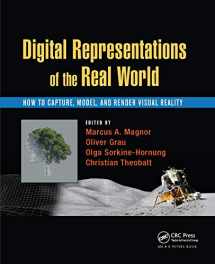
Digital Representations of the Real World: How to Capture, Model, and Render Visual Reality
Book details
Summary
Description
Create Genuine Visual Realism in Computer Graphics
Digital Representations of the Real World: How to Capture, Model, and Render Visual Reality explains how to portray visual worlds with a high degree of realism using the latest video acquisition technology, computer graphics methods, and computer vision algorithms. It explores the integration of new capture modalities, reconstruction approaches, and visual perception into the computer graphics pipeline.
Understand the Entire Pipeline from Acquisition, Reconstruction, and Modeling to Realistic Rendering and Applications
The book covers sensors for capturing 3D scenes, including regular cameras, wide-angle omnidirectional cameras, active range scanners, and plenoptic (multi-viewpoint) cameras, as well as fundamental algorithms for processing the imagery, such as stereo correspondence and 3D structure and motion recovery. It describes 3D modeling techniques, from generic object models (such as 3D meshes) to more domain-specific models (such as human shape and motion models). The book also discusses how techniques, including image- and video-based rendering, meet speed and realism requirements.
Overcome Challenges in Your Own Research Experiments
This book is both an accessible introduction to the emerging research of real-world visual computing and a practical guide that shows you how to start implementing frequently encountered methods.


We would LOVE it if you could help us and other readers by reviewing the book
Book review



